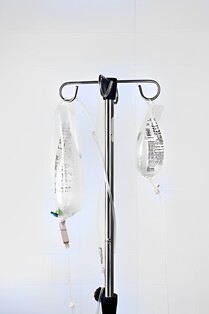Nursing students are usually not taught how to start IVs during school. Sometimes students learn how to start an IV on the job in a structured fashion, sometimes they learn ‘under the table’ from a well-intended staff member during their clinical rotations, and sometimes they just end up winging it and picking up the skill as they go along.
Either way, starting an IV seems to be one of the most anxiety-provoking skills to learn for new nurses.
Therefore, here are a few steps on how to start an IV….
1. Don’t panic. Starting an IV is a learned skill that gets better with practice.
2. Everyone can miss a vein. If missed, try again.
3. Verify the order to place the IV.
4. Verify the patient’s name and date of birth.
5. Prepare supplies before going to the patient.
6. Supplies needed are gloves, tape, bio-occlusive dressing, a tourniquet, a 2×2 gauze, the appropriate IV-gauge needle, alcohol or chlorhexidine swab, IV lock tubing, saline flushes, and a pen.
7. For US needles, the smaller the gauge, the bigger the needle diameter. For example, an 18-gauge needle is larger than a 20-gauge needle. A 20-gauge needle is larger than a 22-gauge needle.
8. Decide what vein to place the IV.
9. Learn to feel for a vein rather than look for a vein. Veins feel different than the surrounding tissue. This is a skill that takes practice.
10. Decide on the appropriate needle gauge before starting. Take into consideration the size of the patient, and the situation at hand. If the patient is a frail elderly person with fragile veins and only needs to get one IV push medication per day, perhaps a 22 Gauge IV is appropriate. If the patient is a severely septic patient, two 18 gauge IV’s can be helpful.
11. Prime the IV tubing with a saline bag. Leave the saline attached to the tubing.
12. Put on appropriately fitting gloves.
13. Place a tourniquet on the arm above the selected vein.
14. Alcohol swab the skin around the area of injection.
15. Remove the cap from the IV needle. Make sure the bevel of the needle is up.
16. Make sure it is known how to engage the release mechanism on the IV needle. Practice on a few needles away from the patient before inserting them into the vein if necessary.
17. Hold the skin the selected vein taut with the non-IV holding hand.
18. Insert the needle with its bevel up. Insert the needle into the vein. Once a blood flashback is seen, release the needle per the needle mechanism.
19. Attach the IV tubing to the end of the empty needle catheter and flush the tubing.
20. Check to make sure there is no swelling or pain around the insertion site into the vein when you are flushing the IV.
21. Cover the IV site with the bio-occlusive dressing. Secure with more tape if necessary.
22. Label the dressing with the date, time and initials.
23. Throw away the supply packaging.
You are now prepared to give any IV medications as ordered.
 By Charlotte-Writer, Educator, Master’s Prepared Nurse
By Charlotte-Writer, Educator, Master’s Prepared Nurse

110 thoughts on “How to Start an IV: An Important Skill for Nurses”
Comments are closed.